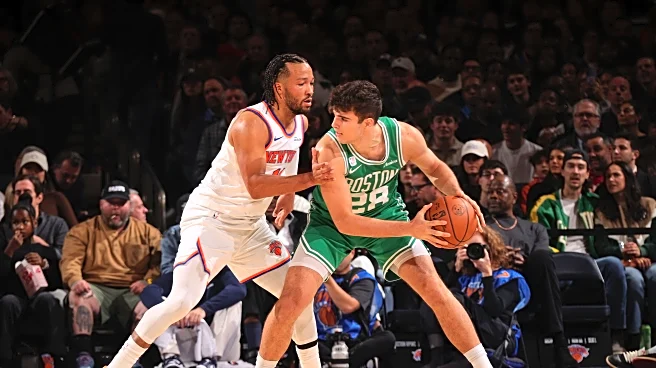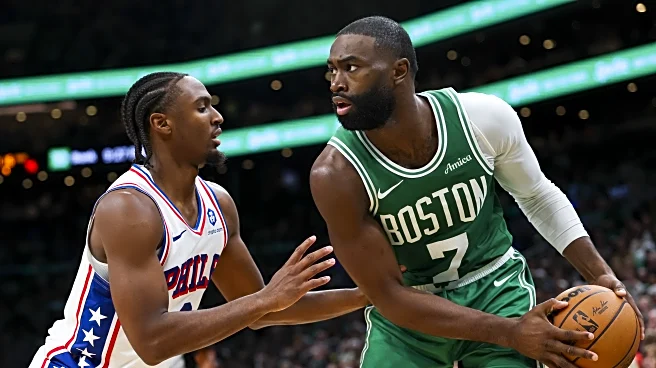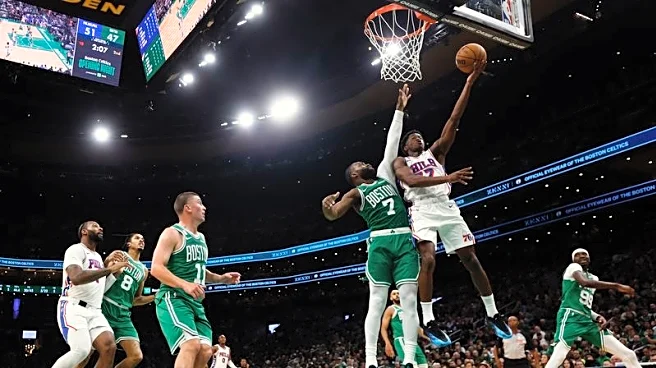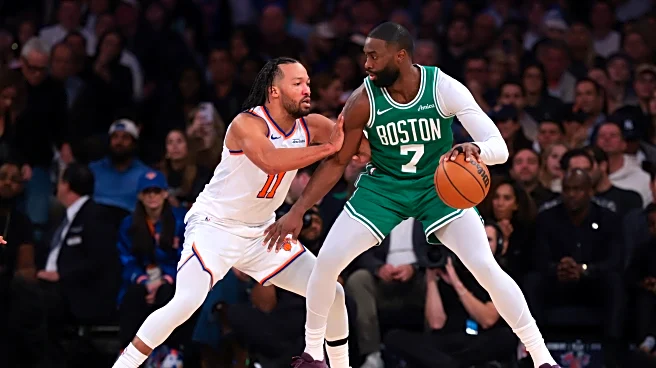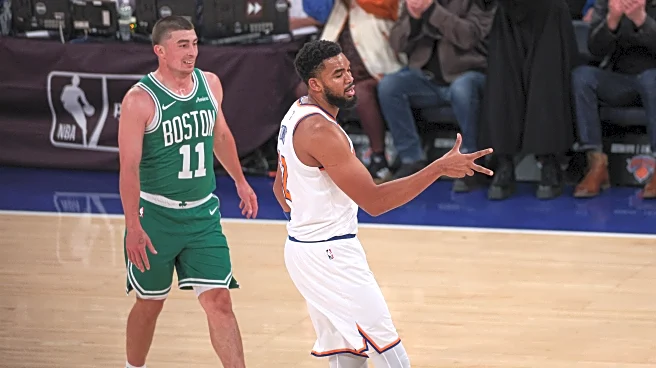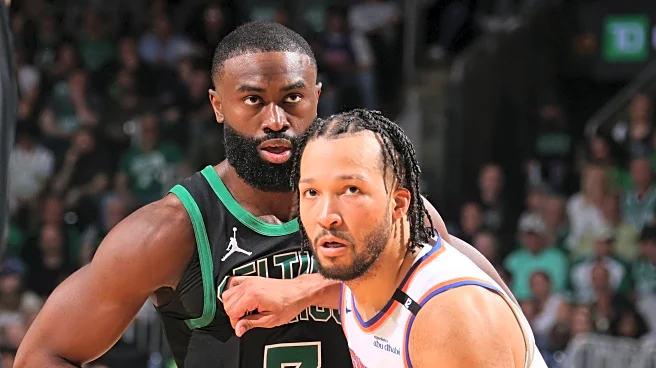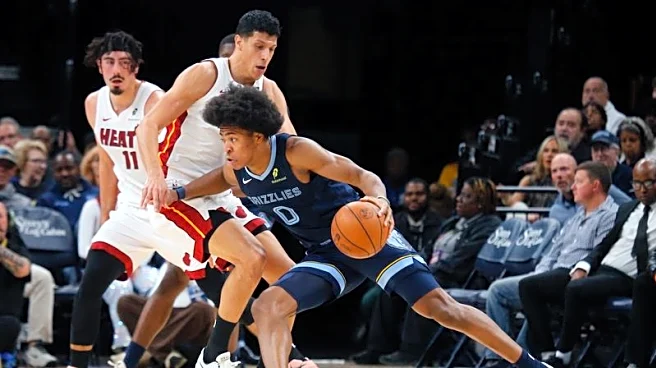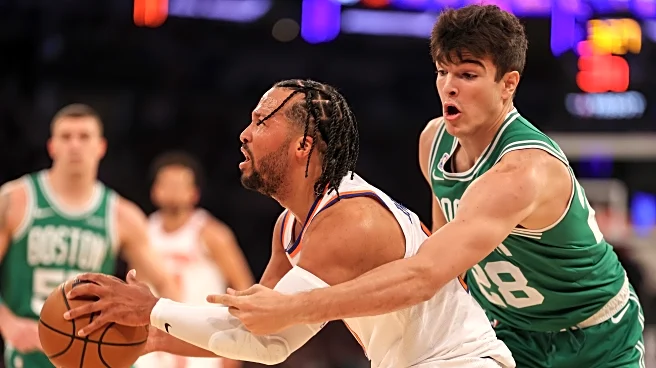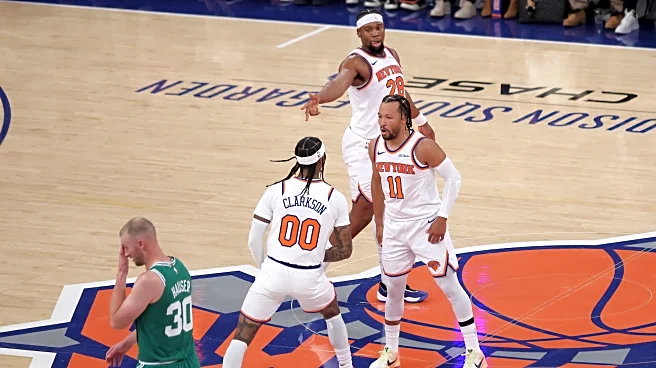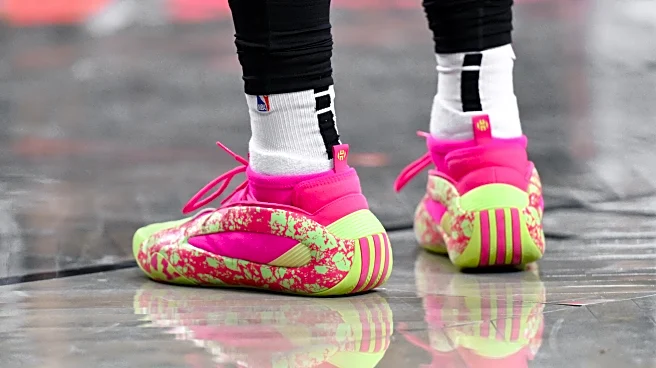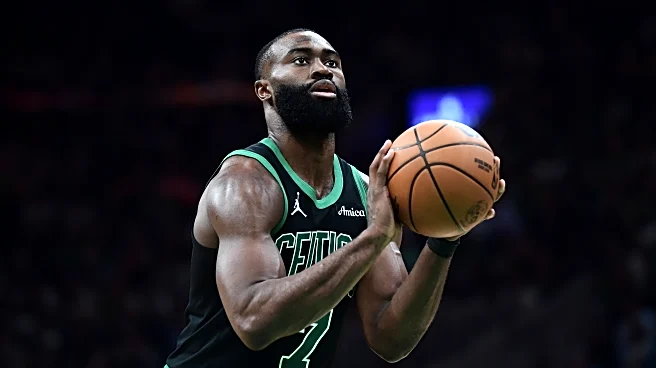#1 – Hugo Gonzales brought life to the Celtics
Looking at the box score, you wouldn’t think Hugo Gonzales had that big of an impact: only six points, one assist, and two steals. Yet, you could also notice that the Celtics won by seven points in the 22 minutes he was on the floor. How? Well, it started with defense — the Celtics held the Knicks to just 87 points per 100 possessions when he was in the game.
This small sample size could be misleading, so let’s look at what Hugo brought defensively. Well, he brought everything he had — and that’s
exactly what the Celtics needed. With him on the court, the Knicks’ ball-handlers couldn’t dictate the game as they wished because they were constantly under pressure. A full-court pressure that generated a stagnant offense and a lot of turnovers for the Knicks.
The defensive work was impressive, but Hugo also brought energy on both sides of the court. In this action, after setting a back screen, he immediately goes for the offensive rebound because he sees the space created and anticipates the missed shot.
Even in half-court sets, his willingness to drive and make quick decisions improved the team’s movement and brought the pace closer to what the Celtics’ offense should look like. His energy turns into speed — and here, he leaves Josh Hart in the dust after the Knicks wing is forced to switch onto him.
There was a lot to like on both ends of the floor, and I’ll give you one more defensive highlight before moving on to the next takeaway.
#2 – Some movement to start the game
We saw that play in the first game to punish Joel Embiid’s lack of mobility — and it worked out pretty well. So, to start this one, the Celtics ran the same play twice in a row to generate open shots. With these Spain pick-and-rolls, they can either create an open three or a shot at the rim.
On the first play, the confusion created by all the screens and movement gives Sam Hauser plenty of space to catch and shoot comfortably.
On the next possession, the Celtics run a similar action, and this time the Knicks are more worried about Hauser’s shot than before… but they leave Queta wide open rolling to the rim.
Two possessions, six points, and a lot of screen and ball movement. Makes you wonder why we don’t see more of those.
They kept going after Karl-Anthony Towns to start the game with another smart play call. Queta first sets a pindown screen for Hauser in the corner. Hauser then runs to set a screen for White. The Celtics’ #0 then starts a Zoom Action, using Hauser’s screen and Queta’s handoff to create separation from Mikal Bridges.
KAT is caught between stepping up on White or covering Queta’s roll, and that’s a beautiful floater for D-White.
#3 – Is Jaylen Brown the Celtics’ center?
Well, if you only focus on the defensive end… yes, he might be! Like against Philly, Brown starts on the opponent’s center while Queta is used on a wing. Here, Queta matches up with Bridges and does a great job bothering him.
Mike Brown makes an early decision to sit Bridges and bring in Landry Shamet, who is far more active off the ball, forcing the Celtics to put Queta on KAT and go back to a more traditional defensive setup.
#4 – Playing small is fun until you need to rebound
A defensive stop doesn’t just mean the opponent missed a shot — it means they missed and didn’t grab the offensive rebound to extend the possession. And that’s where the Celtics failed last night.
Overall, the Knicks had worse shooting efficiency than the Celtics, but because they were able to generate 21 extra possessions through offensive rebounds, they beat Boston by 10.

If the Celtics had managed to limit New York’s offensive rebounds, or forced more of their own, or generated more turnovers, they would have had a much better chance to win the game through the possession battle. In hard defensive games like last night’s, it often comes down to who generates more shots — regardless of quality or efficiency.
#5 – Bench minutes bring good defense
To close the first quarter, Joe Mazzulla went with a brand new lineup, taking all the starters off the floor. The bench — Hugo Gonzales, Chris Boucher, Xavier Tillman, Anfernee Simons, and Baylor Scheierman — brought a ton of defensive energy.
With this group, they applied strong ball pressure and took away easy passes. With a switch-everything approach, they minimized space and forced the Knicks into one-on-one play.
The problem for that lineup was that the offense created nothing and lacked synergy, forcing Mazzulla to bring Brown back into the game quickly.
#6 – A defensive collapse summed up in one sequence
In 12 minutes, the Knicks scored 42 points on the Celtics and built a 20-point lead by halftime, despite Boston’s great first quarter. While the Celtics’ offense struggled to convert open threes, the bigger problem came on defense.
In that stretch, New York made 12 field goals, 12 free throws, and grabbed seven offensive rebounds. Their spacing and constant movement overwhelmed Boston’s defense, and the shots were often open. On top of that, when the Knicks missed, they dominated the glass.
At the end of this sequence, New York ran a pretty basic baseline action — and Queta forgot to help Hauser after Guerschon Yabusele’s screen, leaving Bridges open at the rim.
#7 – Lack of spacing and court awareness led to transition points

Look at the screenshot below. It’s an image we rarely saw before when Brown was posting up. There are three defenders on him because Pritchard, Tillman, and Simons are way too close. The Knicks eat up the space, generate turnovers, and score in transition.
The Knicks scored 23 points in transition — and spacing was a big reason for it. The other cause was Brown’s lack of court awareness. After a six-game playoff series, he should know the Knicks will swarm him as soon as he drives. Yet, he still got caught often, finishing with seven turnovers in 35 minutes.
#8 – More speed in the fourth
After seven quarters of somewhat slow offense, the Celtics finally matched the pace that was promised all summer. It started on defense, and as mentioned in #1, that came from the ball pressure led by Hugo Gonzales. But speed can also be created from scratch, even after a made basket.
Here, after another defensive mistake from Brown and Queta, D-White sprints to the other end before the defense can set up and gives those two points right back to the Knicks. The Pacers over the last two years showed the league that you don’t need defense to play fast on offense — just run, and keep running, whether the previous possession was a make or a miss.
#9 – The shooting struggles continue
Aside from Sam Hauser’s good night from deep, the rest of the Celtics shot just 26% from three. Some of those were open looks, but the difficulty of many attempts explains the inefficiency. It’s part of the learning process — but with fewer high-quality shots than before, the Celtics need to find new ways to capitalize on the gaps they create.
#10 – The wing rotation battle is just getting started
22 minutes for Hugo Gonzales, four for Scheierman, two for Jordan Walsh, none for Josh Minott… who will claim the backup wing spot? Time will tell, but Gonzales definitely led the charge after last night’s game at Madison Square Garden.
